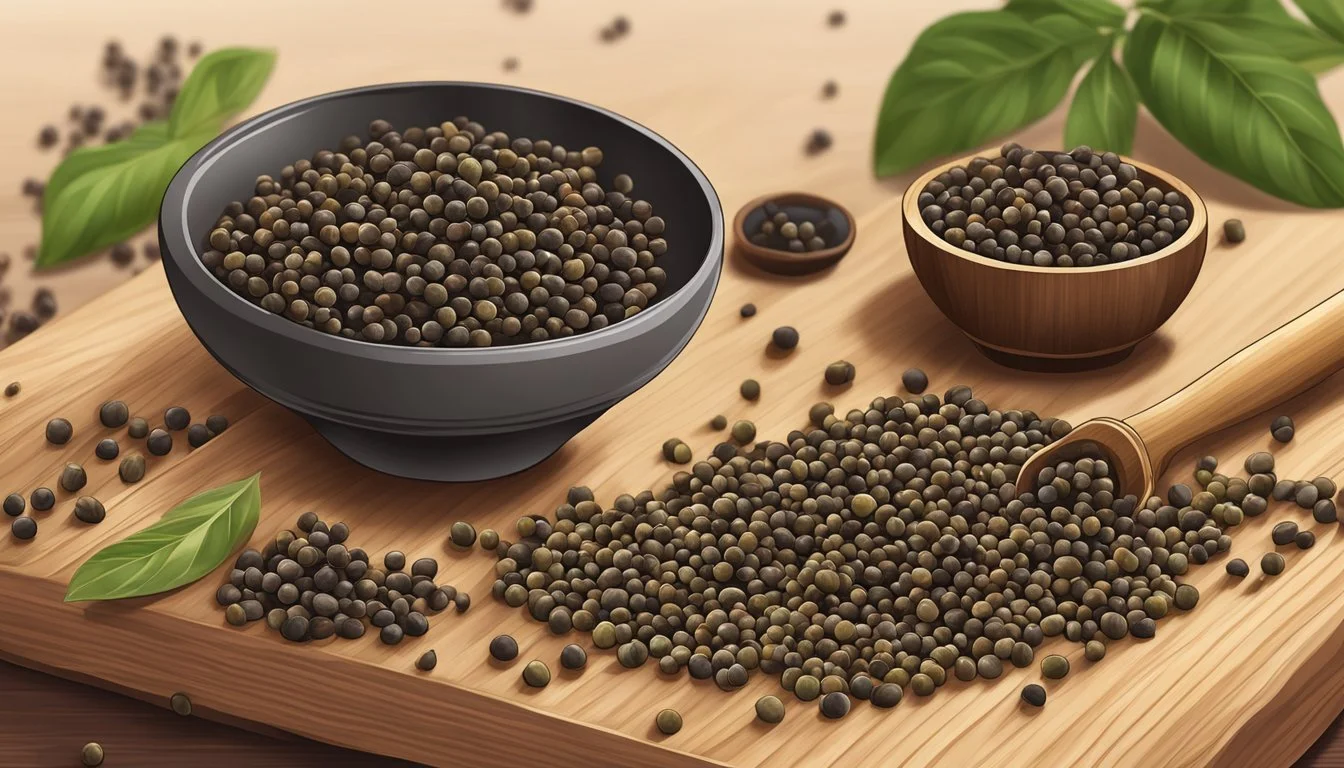Szechuan Peppercorns Substitutes
Best Alternatives for Authentic Flavors
For those passionate about Chinese cuisine, the unique flavor profile of Szechuan peppercorns is irreplaceable. Known for its numbing sensation and citrusy tang, it plays a crucial role in creating authentic Szechuan dishes. Yet, not everyone has easy access to this distinctive spice.
A great substitute for Szechuan peppercorns is lemon pepper seasoning, which replicates the tangy, slightly spicy flavor quite well. Additionally, Tellicherry peppercorns can offer a robust and aromatic replacement. If you're looking to mimic both the flavor and numbing sensation, sansho powder from Japanese cuisine is another excellent option.
Grains of paradise, known for their pungent and slightly citrusy taste, also serve as a worthwhile alternative. Another viable combination includes black pepper and coriander seeds, which together bring a blend of pungency and citrus hints that closely matches Szechuan peppercorns. With these substitutes, home cooks can still recreate the exotic flavors of Chinese cuisine without compromising the essence of their dishes.
Understanding Szechuan Peppercorns
Szechuan peppercorns, native to the Sichuan Province of China, are known for their unique aroma and numbing sensation, and play an integral role in Szechuan cuisine.
Characteristics of Szechuan Peppercorn
Szechuan peppercorns are not true peppercorns but dried husks of the prickly ash shrub. They are reddish-brown and have a rough, uneven texture. The aroma is distinctly floral and citrusy, reminiscent of lavender and lemon. When ground, Szechuan peppercorns release a fragrant oil that adds complexity to dishes.
The key feature of Szechuan peppercorns is their active compound, hydroxy-alpha-sanshool. This compound creates a tingling, numbing sensation on the tongue, enhancing the spiciness of chili peppers when used together.
Role in Szechuan Cuisine
In Szechuan cuisine, Szechuan peppercorns are a staple ingredient, crucial for achieving the cuisine's signature "mala" flavor, which translates to "numbing and spicy." These peppercorns are often used in hot pot, kung pao chicken, and twice-cooked pork.
Szechuan peppercorns are a component of Chinese Five Spice powder, alongside star anise, cloves, cinnamon, and fennel seeds. This spice blend is essential in creating the complex layers of flavor characteristic of many Szechuan dishes.
Szechuan Peppercorn's Unique Sensation
The numbing sensation produced by Szechuan peppercorns is a hallmark of dishes from the Sichuan region. This sensation, described as "tingly" or "electric," helps to balance the intense heat of the cuisine's chili peppers. Hydroxy-alpha-sanshool, the compound responsible, activates nerve receptors in the mouth, resulting in the distinctive mouthfeel.
This tingling effect heightens the experience of eating Szechuan cuisine, making it a favorite among those who enjoy vibrant and bold flavors. The numbing sensation can make spicy foods seem less overwhelming, allowing diners to appreciate the nuanced flavors of the other ingredients.
Commonly Used Substitutes for Szechuan Peppercorns
The distinctive tingling and numbing sensation of Szechuan peppercorns can be replicated using various substitutes. Each substitute offers unique flavors that can enhance and complement different dishes.
Tellicherry Pepper
Tellicherry Peppercorns are renowned for their robust and complex flavor profile. These peppercorns originate from the same plant as black pepper but are allowed to ripen longer on the vine. This results in a larger, more mature peppercorn that offers a more nuanced taste.
Use Tellicherry Peppercorns in a 1:1 ratio as a substitute for Szechuan peppercorns. While they lack the numbing sensation, they add a rich, bold flavor that can enhance savory dishes. Toasting the peppercorns before use can release more aromatic oils, adding depth to your culinary creations.
Tasmanian Pepper
Tasmanian Pepper, also known as mountain pepper, provides a berry-like sweetness combined with a peppery heat. This spice is particularly noted for the slight numbing sensation it can produce, somewhat similar to Szechuan peppercorns.
To substitute, use Tasmanian Pepper in a 1:1 ratio. Its unique combination of sweet and spicy elements makes it ideal for marinades, sauces, and stews. It’s also favored in fusion cuisine where a touch of heat and sweetness can elevate the dish.
Sansho Pepper
Sansho Pepper, made from the ground berries of the Japanese pepper bush, offers a tangy, citrusy flavor with a numbing effect similar to Szechuan peppercorns. Despite its differences in botanical origin, Sansho pepper can be a compelling substitute.
Substitute Sansho powder in equal amounts for a similar numbing experience. It’s especially useful in dishes that benefit from a bright, citrus undertone. Ensure that it’s added towards the end of cooking to preserve its distinctive flavor and numbing properties.
Grains of Paradise
Grains of Paradise are small, reddish-brown seeds from the Aframomum melegueta plant. They impart a complex blend of flavors, combining notes of black pepper, citrus, and a hint of cardamom. Although not identical, they can mimic some flavor characteristics of Szechuan peppercorns.
Use Grains of Paradise as a 1:1 substitute. Their versatility allows them to blend well in both sweet and savory dishes. Crush the seeds to release their aromatic properties before incorporating them into your recipe. This spice is particularly suited for rubs, stews, and complex spice blends.
Citrusy Substitutes
When looking for substitutes for Szechuan peppercorns, citrusy options like lemon zest, coriander seeds, and sumac bring a refreshing twist to your dishes with their unique, tangy flavors.
Lemon Zest
Lemon zest is a readily available and versatile ingredient. The outer peel of the lemon, known for its bright, citrusy flavor, can effectively mimic the tanginess of Szechuan peppercorns.
For substitution, a mixture of lemon zest and black pepper in a 1:1 ratio works well. This combination not only imparts a refreshing taste but also enhances the overall flavor profile due to the pepper's heat.
Lemon zest's ease of use makes it ideal for various recipes, bringing a zesty kick without overwhelming the other ingredients. This substitute is especially helpful when a light, citrus note is desired, complementing both Asian and Western dishes effortlessly.
Coriander Seeds
Coriander seeds bring a distinct fruity and citrusy flavor to your dishes. Though milder than Szechuan peppercorns, coriander seeds can subtly emulate the unique taste needed in recipes.
To make them a more fitting substitute, it's common to mix them with black pepper to add some heat and depth. This combination provides a balanced flavor that can stand in for Szechuan peppercorns, particularly in sauces and marinades.
Coriander seeds are not just aromatic but also versatile. Their gentle, citrusy notes make them suitable for a wide range of cuisines, enhancing the dish without overpowering the other flavors.
Sumac
Sumac is a spice known for its tangy and citrusy flavor, making it an excellent substitute for Szechuan peppercorns. Derived from dried and ground berries, it imparts a vibrant red hue alongside its tartness.
Sumac can be used alone or with a pinch of black pepper to replicate the spicy kick of Szechuan peppercorns. It's particularly effective in rubs, dressings, and dips, providing a lemony essence that brightens up the dish.
Incorporating sumac into your cooking not only mimics the citrusy zest but also adds a unique, slightly sour note that enhances the overall flavor balance, making it a versatile addition to your spice rack.
Spice Blends as Alternatives
When seeking substitutes for Szechuan peppercorns, certain spice blends can effectively replicate their unique flavors. Chinese Five-Spice Powder and Japanese Seven-Spice Seasoning are two excellent choices.
Chinese Five-Spice Powder
Chinese Five-Spice Powder, a blend traditionally used in Chinese cuisine, consists of star anise, cloves, Chinese cinnamon, Sichuan peppercorn, and fennel seeds.
This combination offers a balance of sweet, sour, bitter, pungent, and salty flavors, making it a versatile substitute. It captures the numbing sensation of Sichuan peppercorns, although it might slightly alter the dish’s flavor profile due to the presence of other spices.
Using this blend in marinades, stir-fries, or braised dishes can achieve a complex and robust taste. The key is to adjust the quantity to match your taste preferences, typically using a 1:1 ratio as a starting point.
Japanese Seven-Spice Seasoning
Shichimi Togarashi, or Japanese Seven-Spice Seasoning, is another viable option. It includes red chili pepper, sansho pepper, sesame seeds, dried orange peel, seaweed, ginger, and poppy seeds.
Sansho pepper, a relative of Sichuan peppercorn, provides the same numbing effect, complemented by other aromatic and flavor-boosting ingredients. This seasoning is ideal for sprinkling over noodles, grilled meats, and soups.
Adjusting the amount to suit your heat tolerance and flavor preference is essential, as Shichimi Togarashi can be more pungent than Sichuan peppercorns. It brings a bright, complex spiciness to any dish.
Making the Best Use of Substitutes
Selecting the right substitute for Szechuan peppercorns demands consideration of quantity and flavor profile. Focus on how best to incorporate alternatives into various cooking techniques to preserve or enhance dish integrity.
Considering Flavor Profile and Quantity
When substituting Szechuan peppercorns, matching the flavor profile is crucial.
Sansho powder, derived from Japanese pepper bush berries, serves as an effective substitute. It offers a tangy, spicy flavor with a citrus hint. Use a 1:1 ratio to replace Szechuan peppercorns, making it a versatile choice for meat dishes and soups.
Lemon zest combined with black or white pepper provides a fruity yet pungent experience. Substitute ½ tsp lemon zest and ½ tsp pepper for every 1 tsp of Szechuan peppercorns. This combination works well in stir-fries where a bright, sharp note is needed.
Sechuan Buttons, also known as "electric buttons," offer a tingling sensation similar to Szechuan peppercorns but differ in taste. Use these in dishes requiring the numbing effect, carefully adjusting quantities based on the intensity of the buttons.
Adjustments for Cooking Techniques
Stir-Fries benefit from quick incorporation of substitutes. Sansho powder or a lemon zest and pepper mix can easily be added during the final stages of cooking. This ensures flavors don't diminish under high heat.
In soups, it's essential to add substitutes early during the simmering process. This allows the flavors to meld. Sansho powder can easily integrate without overwhelming the dish.
Meat dishes like braised or grilled meats demand a robust substitute that can endure longer cooking times. Sechuan Buttons can be sprinkled sparingly. Alternatively, the lemon zest and pepper blend can marinate meats for a balanced, flavorful profile.
Each substitute brings unique characteristics, so adjust quantities and cooking techniques to suit specific dishes. This approach ensures that flavor integrity is maintained or enhanced.
Where to Find Substitutes
Substitutes for Szechuan peppercorns can be found in various locations. One common place is local grocery stores. Look in the spice aisle where other commonly used spices are stocked.
Asian stores are another excellent option. They often have a wider variety of spices, including those that serve as good substitutes for Szechuan peppercorns.
Online retailers also provide an array of options. Websites like Amazon or specialty spice retailers often carry substitutes such as Sansho powder, Grains of Paradise, or Tellicherry peppercorns.
List of Common Substitutes:
Lemon pepper seasoning
Sansho powder
Tellicherry peppercorns
Grains of Paradise
Sumac and red pepper flakes mix
Ground black pepper and ground coriander seeds
For quick reference:
Sansho powder and Tellicherry peppercorns can usually be found in specialty spice stores.
Sumac and red pepper flakes mix might be available in local grocery stores.
When visiting local Asian markets, you are more likely to find traditional substitutes and unique options that are not typically found in conventional grocery stores. Using these resources helps ensure that you can replicate the distinctive taste and sensory experience of Szechuan peppercorns in your dishes.
Pairing Substitutes with Food Types
Selecting the right substitutes for Szechuan peppercorns is crucial to maintaining the vibrant and unique flavors in various dishes. Careful pairing ensures meals remain delicious and authentic.
Pairing with Vegetables
Vegetables can benefit from the boldness of substitutes like lemon pepper seasoning or Grains of Paradise. Lemon pepper adds a zesty brightness, while Grains of Paradise offer a complex, peppery flavor with hints of citrus and cardamom. This combination works well with stir-fries and roasted vegetables.
Sansho powder, known for its numbing sensation, is another excellent choice. It pairs harmoniously with leafy greens and root vegetables, enhancing dishes with its citrusy undertone. Using these substitutes in a 1:1 ratio ensures the flavors are balanced.
Pairing with Chicken and Seafood
For chicken and seafood, substitutes must complement their mild flavors without overpowering them. Tellicherry peppercorns can be used due to their robust, slightly citrusy profile. This pepper is ideal for grilled or roasted chicken and seafood dishes.
Lemon zest, combined with black or white pepper, provides a subtle yet effective replacement. The fruity notes of lemon zest elevate the flavors in dishes like lemon pepper chicken or citrus-marinated seafood. A mix of ½ tsp lemon zest and ½ tsp pepper for every 1 tsp Szechuan peppercorns works well here.
Pairing with Noodles and Soups
When it comes to noodles and soups, the flavor of substitutes must be delicately balanced to avoid overwhelming the dish. Sansho powder or Grains of Paradise can impart a similar numbing spice and citrusy flavor, essential for achieving the desired taste in hot and sour soups or spicy noodle dishes.
Lemon pepper seasoning can be an excellent alternative in noodle dishes, providing a tangy and spicy kick. Adding these spices in a 1:1 ratio to the original Szechuan peppercorn measurement ensures the integrity of the dish remains intact.
Using Substitutes in Sichuan Recipes
Many people love Sichuan cuisine for its distinct flavors, often highlighted by Sichuan peppercorns. When unavailable, various substitutes can still deliver similar sensations in popular dishes.
Mapo Tofu with Substitutes
Mapo Tofu relies on the numbing effect of Sichuan peppercorns to balance its spicy heat. Tellicherry peppercorns or grains of paradise can be used in a 1:1 ratio to achieve a robust, spicy flavor.
Another option is Sansho powder, which offers a similar numbing sensation. To replicate the citrus notes, a mixture of lemon zest and black pepper can be combined. Ensure even distribution to avoid concentrated flavors.
Kung Pao Chicken Adaptation
In Kung Pao Chicken, substituting Sichuan peppercorns affects the dish's zing. Utilizing Tellicherry peppercorns ensures a maintain of aromatic intensity. For a different twist, combine black pepper with coriander seeds in a 1:1 ratio.
This blend adds a citrusy hint needed for authenticity. Adjust the quantity based on personal preference for numbing spice, especially if using Sansho powder, known for its strong numbing effect.
Sichuan Noodle Dishes
Noodle dishes in Sichuan cuisine benefit from the unique bite of Sichuan peppercorns. Grains of paradise serve as a close substitute due to their peppery, slightly citrusy flavor. Sansho powder provides a more traditional numbing experience.
Alternatively, mix lemon pepper seasoning with crushed black pepper for a more accessible replacement. Each substitute should be tested in small batches to perfect the balance suitable for individual palates. Adapt the spice levels gradually to maintain the desired authentic experience.







